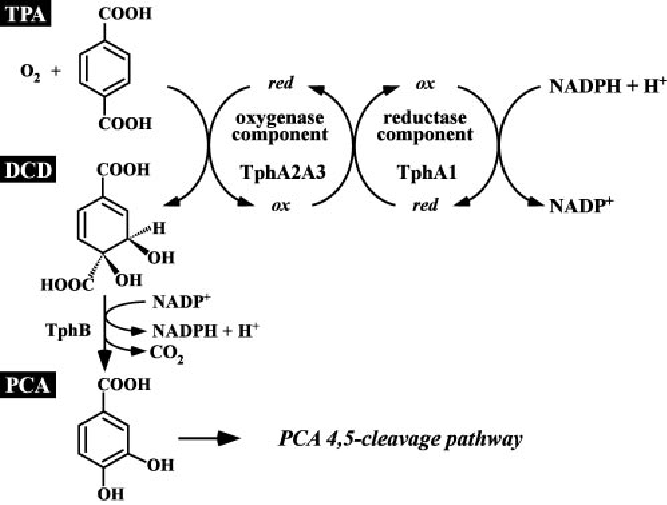Team:TU Darmstadt/Project/Metabolism
From 2012.igem.org
Metabolism
The group metabolism is employed to create a new metabolic pathway in E. coli. This pathway enables it to convert terephthalic acid (TPA) in high grade fine and bulk chemicals respectively.
After degradation of polyethylene therephalate (PET) by enzymes presented on the surface, a tripartite tricarboxylate transport system transfers the monomers into the cytoplasm. The new metabolic pathway consists of five cytoplasmatic enzymes and converts terephthalic acid into catechol.
The first reaction of the pathway is catalyzed by a terephthalic acid 1,2-dioxygenase system (TERDOS). This system is a natural enzyme complex from C. testosteroni – KF1 and consists of three enzymes (TphA1, TphA2 and TphA3). TERDOS catalyzes the NAD+ depended reaction from terephthalic acid to (1R,2S)-dihydroxy-3,5-cyclohexadiene-1,4-dicarboxylic acid (DCD). The second reaction converts the DCD to protocatechuic acid. The enzyme involved in the reaction is called TphB, a dihydrodiol decarboxylase. Protocatechuic acid is a central microbiological metabolite. The final metabolic step is the decarboxylation of protocatechuic acid by AroY.
A sixth enzyme was introduced to cope with the need of verification. XylE catalyzes the reaction from catechol to 2-hydroxysemialdehyd – cis - muconic acid (2-HSM). 2-HSM has a yellowish colour in solution and can be detected by a simple photometric analysis.
We constructed a gene cassette coding for TphA1, TphA2, TphA3, TphB, AroY and XylE. The expression of XylE only is regulated by an L(+)-arabinose inducible promoter while the remaining genes are regulated by a promoter for a constitutive expression. Thus catechol production can easily be verified by simply inducing a culture sample with L(+)-arabinose and incubating it for 2 hours afterwards. This could proof as an excellent system for the production of catechol from terephthalate acid. Detailed information is available in our labjournal.
During our experiments we successfully overexpressed all proteins of our metabolic pathway and confirmed the suggested oligomerizations of the homodimer of TphB, the homotrimer of TphA3 and the homopentamer of AroY. Furthermore we characterised the BioBrick XylE from the parts registry and discovered protocatechuic acid to be an alternative substrate for XylE - including a striking difference in its kinetics. As our results show, anaerobic conditions are crucial for this final step because AroY proved to be sensitive to oxygen exposure. Finally we used XylE to prove AroY's activity in catalyzing our final step from protocatechuate to catechol.
For further reading continue to 4. Material Science.
 "
"
